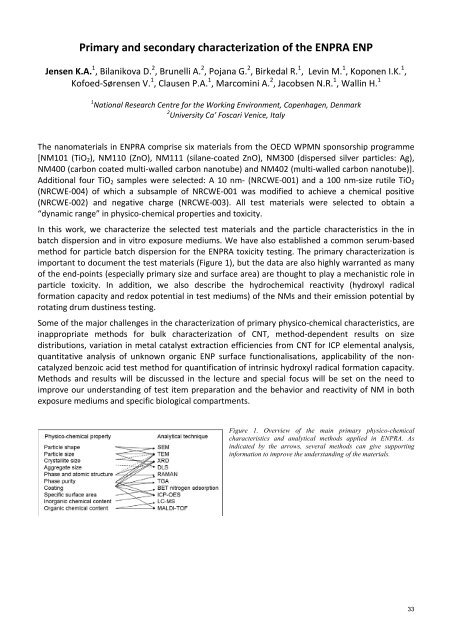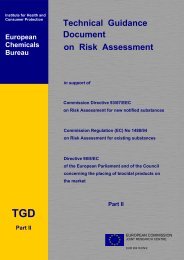Challenges of Regulation and Risk Assessment of Nanomaterials
Challenges of Regulation and Risk Assessment of Nanomaterials
Challenges of Regulation and Risk Assessment of Nanomaterials
You also want an ePaper? Increase the reach of your titles
YUMPU automatically turns print PDFs into web optimized ePapers that Google loves.
Primary <strong>and</strong> secondary characterization <strong>of</strong> the ENPRA ENP<br />
Jensen K.A. 1 , Bilanikova D. 2 , Brunelli A. 2 , Pojana G. 2 , Birkedal R. 1 , Levin M. 1 , Koponen I.K. 1 ,<br />
K<strong>of</strong>oed-Sørensen V. 1 , Clausen P.A. 1 , Marcomini A. 2 , Jacobsen N.R. 1 , Wallin H. 1<br />
1 National Research Centre for the Working Environment, Copenhagen, Denmark<br />
2 University Ca’ Foscari Venice, Italy<br />
The nanomaterials in ENPRA comprise six materials from the OECD WPMN sponsorship programme<br />
[NM101 (TiO2), NM110 (ZnO), NM111 (silane-coated ZnO), NM300 (dispersed silver particles: Ag),<br />
NM400 (carbon coated multi-walled carbon nanotube) <strong>and</strong> NM402 (multi-walled carbon nanotube)].<br />
Additional four TiO2 samples were selected: A 10 nm- (NRCWE-001) <strong>and</strong> a 100 nm-size rutile TiO2<br />
(NRCWE-004) <strong>of</strong> which a subsample <strong>of</strong> NRCWE-001 was modified to achieve a chemical positive<br />
(NRCWE-002) <strong>and</strong> negative charge (NRCWE-003). All test materials were selected to obtain a<br />
“dynamic range” in physico-chemical properties <strong>and</strong> toxicity.<br />
In this work, we characterize the selected test materials <strong>and</strong> the particle characteristics in the in<br />
batch dispersion <strong>and</strong> in vitro exposure mediums. We have also established a common serum-based<br />
method for particle batch dispersion for the ENPRA toxicity testing. The primary characterization is<br />
important to document the test materials (Figure 1), but the data are also highly warranted as many<br />
<strong>of</strong> the end-points (especially primary size <strong>and</strong> surface area) are thought to play a mechanistic role in<br />
particle toxicity. In addition, we also describe the hydrochemical reactivity (hydroxyl radical<br />
formation capacity <strong>and</strong> redox potential in test mediums) <strong>of</strong> the NMs <strong>and</strong> their emission potential by<br />
rotating drum dustiness testing.<br />
Some <strong>of</strong> the major challenges in the characterization <strong>of</strong> primary physico-chemical characteristics, are<br />
inappropriate methods for bulk characterization <strong>of</strong> CNT, method-dependent results on size<br />
distributions, variation in metal catalyst extraction efficiencies from CNT for ICP elemental analysis,<br />
quantitative analysis <strong>of</strong> unknown organic ENP surface functionalisations, applicability <strong>of</strong> the noncatalyzed<br />
benzoic acid test method for quantification <strong>of</strong> intrinsic hydroxyl radical formation capacity.<br />
Methods <strong>and</strong> results will be discussed in the lecture <strong>and</strong> special focus will be set on the need to<br />
improve our underst<strong>and</strong>ing <strong>of</strong> test item preparation <strong>and</strong> the behavior <strong>and</strong> reactivity <strong>of</strong> NM in both<br />
exposure mediums <strong>and</strong> specific biological compartments.<br />
Figure 1. Overview <strong>of</strong> the main primary physico-chemical<br />
characteristics <strong>and</strong> analytical methods applied in ENPRA. As<br />
indicated by the arrows, several methods can give supporting<br />
information to improve the underst<strong>and</strong>ing <strong>of</strong> the materials.<br />
33








